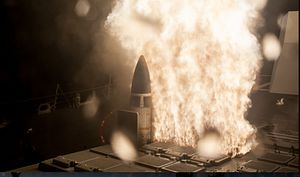The U.S. Department of State approved the possible sale of eight Standard Missile-3 (SM-3) Block IB missiles and 13 Standard Missile-3 (SM-3) Block IIA missiles for an estimated cost of $561 million on November 16, the Pentagon’s Defense Security Cooperation Agency (DSCA) announced in a press statement. The foreign military sale is still subject to congressional approval.
The SM-3 Block IIA missile is the most advanced version of the SM-3 “hit-to-kill” interceptor, which has been under joint development by U.S. defense contractor Raytheon and Japan’s Mitsubishi Heavy Industries since 2006. The SM-3 Block IIA missile is expected to be operational in the coming months.
“Whereas Raytheon is responsible for the SM-3 Block IIA’s hardware, system development, and all-up-round integration, MHI oversees the development of the interceptor missile’s second- and third-stage rocket motors, steering control, and the missile nosecone,” I explained previously.
The U.S. Missile Defense Agency (MDA) and U.S. Navy last successfully conducted an intercept of a medium-range ballistic missile target with a SM-3 Block IIA missile on October 26. Prior to that, a previous successful test of a SM-3 Block IIA missile interceptor took place in February 2017. Two other tests of the SM-3 Block IIA in June 2017 and January 2018 respectively failed. As I reported elsewhere:
The SM-3 Block IB interceptor is an upgraded variant of the SM-3 fitted with an enhanced two-color infrared seeker and features an upgraded steering and propulsion capability. The supersonic missile is designed to destroy incoming short- to intermediate-range ballistic missile targets in midcourse.
(…)
The SM-3 Block IIA is designed to destroy short- to intermediate-range ballistic missiles. Possessing a much greater horizontal and vertical range than its predecessors, the SM-3 Block IA and SM-3 Block IB, the SM-3 IIA missile is thought to have a maximum operational range of 2,500 km (1,350 miles). It also carries a much more advanced kill vehicle than previous SM interceptor variants.
The other missile, the SM-3 Block IB interceptor is an upgraded variant of the original SM-3 equipped with an enhanced two-color infrared seeker and features an upgraded steering and propulsion capability. The SM-3 Block IB supersonic interceptor, first flight tested in 2011, is designed to destroy incoming short- to intermediate-range ballistic missile targets in midcourse. Its maximum operational range is approximately 700 kilometers.
“The proposed sale will provide Japan with an increased ballistic missile defense capability to assist in defending the Japanese homeland and U.S. personnel stationed there,” the November 16 statement reads. “Japan will have no difficulty absorbing these additional munitions and support into the Japan Maritime Self Defense Force (JMSDF).”
The sale also includes SM-3 IB and IIA missile canisters. In January, the U.S. State Department also approved a potential sale of SM-3 Block IIA missiles to Japan for an estimated cost of $133.3 million.

































